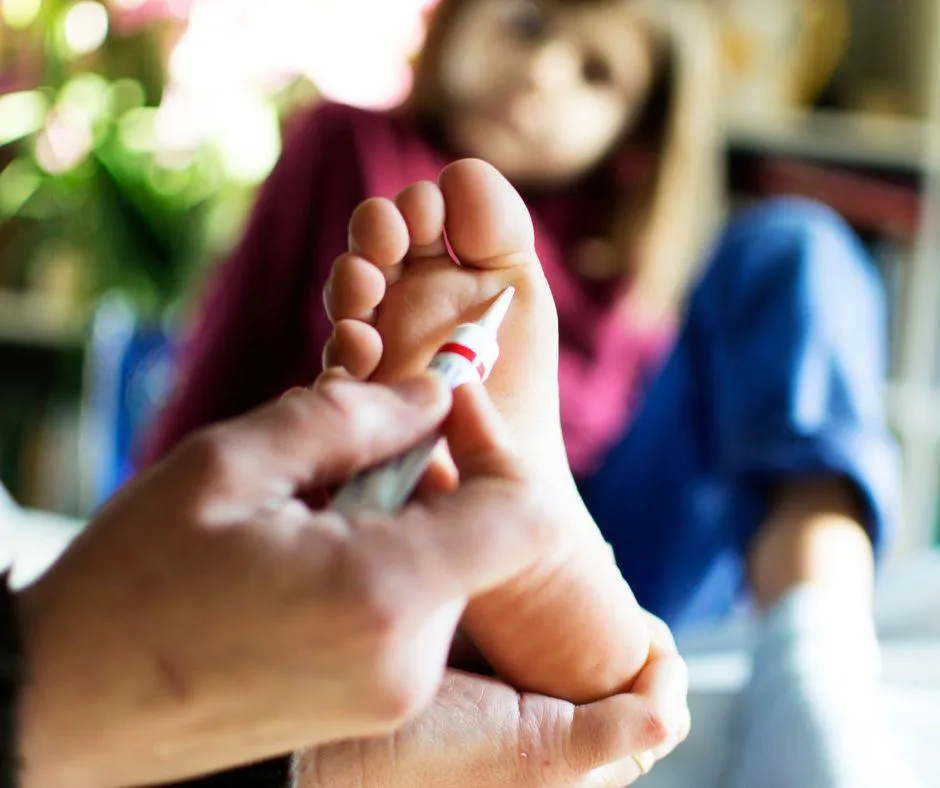
We have all been there, neglected a niggle in our foot and told ourselves that it would probably go away. Weeks have passed, even months, and it’s only getting worse. Then finally, when we are hobbling around barely able to walk, we decide to seek help…
Well, at Achilles Foot Clinic, we are here to help you.

I Have a Verruca, Should I Treat It or Not? - What to Consider
Verrucas, also known as plantar warts, are a common foot ailment caused by the human papillomavirus (HPV). They typically appear on the soles of the feet and can be a source of discomfort and concern for those who have them.
One of the most frequently asked questions in Achilles Foot Clinic is whether to treat a verruca or leave it alone. In this blog, we'll delve into the factors you should consider when deciding whether to treat a verruca or take a wait-and-see approach.
Location and Size
The first thing to consider when deciding whether to treat a verruca is its location and size. Verrucas on weight-bearing areas of the foot, such as the heel or ball of the foot, can cause significant pain and discomfort. Larger verrucas are more likely to be symptomatic and may interfere with your daily activities. If the verruca is causing you pain or discomfort, it's a good idea to seek treatment.
Duration
Verrucas can be stubborn and may persist for months or even years without treatment. However, some verrucas may resolve on their own over time. If you've had a verruca for an extended period, it's worth considering treatment options. A podiatrist can help determine the best course of action based on the verruca's duration and characteristics.
Symptoms
Pay close attention to any symptoms associated with your verruca. If you experience pain, tenderness, itching, or notice bleeding from the verruca, it's a sign that it may be worth treating. These symptoms can affect your quality of life and should not be ignored.
Risk of Spreading
Verrucas are contagious and can spread to other areas of your foot or to other people if proper precautions are not taken. If you have multiple verrucas or a verruca in a location prone to friction and pressure, consider treatment to prevent the spread of the virus.
Impact on Daily Life
Finally, think about how your verruca is affecting your daily life. Are you avoiding certain activities or footwear because of it? Is it causing you discomfort while walking or exercising? If your verruca is interfering with your ability to lead a normal, active life, it may be time to explore treatment options.
Treatment Options
When it comes to treating verrucas, there are many options available:
1.Freezing
This painful treatment is applied using liquid nitrogen to the verruca. The idea is to freeze the verruca virus inside the infected cells, but the skin on the sole of your foot is so thick that this tends not to work and instead causes painful blistering.
2.Chemical Acids
Using toxic chemicals to burn away the verruca is a more traditional treatment. However, this method requires keeping the dressing on and keeping it dry constantly to stop the acid from getting diluted ie. no swimming, keeping it dry in the shower etc., for approximately six weeks. To be honest, this is a pain in the backside for most patients.
3. Surgery
Surgical removal of verruca is normally done in a hospital. It's not something I'd recommend as you have to spend a lot of time off of your foot, and it usually leaves scarring that will never go and can even cause more problems afterwards than the verruca did in the first place.
4.Over-the-counter products
Over-the-counter products have many options, all of which are very weak for safety reasons. Usually, these result in injury to the skin around the verruca rather than treating the verruca itself.
5.Verruca Microwave Therapy
It is the most up-to-date technology in the treatment of verrucas. This new Verruca Microwave Therapy passes cutting-edge microwaves safely through the skin's layers to ZAP the Verruca while leaving no burns or scarring. Another benefit is that it doesn't use toxic chemicals, allowing immediate return to full activity.
No Need To Make Any Scalpel Incisions
No Need Use Any Needles
No Painful Burns From Using Toxic Chemicals
No Need For Taking Time Off Work, Get Treatment During Lunch
No Need To Stop Sports, Even Swimming
No Need For Fiddling With Daily Nuisance Dressings
In plain language, a probe is applied to the verruca and a blast of microwave energy is passed through the verruca for about 3-5 seconds. This heats the verruca to approximately 70 degrees Celsius, triggering the immune system to produce an immune response and kill off the verruca.
No Need To Make Any Scalpel Incisions No Need Use Any Needles No Painful Burns From Using Toxic Chemicals No Need For Taking Time Off Work, Get Treatment During Lunch No Need To Stop Sports, Even Swimming No Need For Fiddling With Daily Nuisance Dressing.
In the end, whether to treat a verruca or not depends on many factors, including location, size, duration, symptoms, risk of spreading, and impact on your daily life.
If you're unsure about the best course of action, it's always a good idea to consult with a podiatrist. At Achilles Foot Clinic we can assess your specific situation and recommend the most appropriate treatment option to help you get back on your feet comfortably and verruca-free.
Remember that early treatment often leads to quicker resolution and less discomfort, so don't hesitate to seek professional advice if you're dealing with a troublesome verruca.
Call Us Now On 0212021001
OR
Fill Out The Form Below And Request A Call From One Of The Achilles Foot Clinic Team
Ask Lorcan And His Team
Fill in the form to request a Call From Our Team
Fill in the form to request a Call From Our Team
One of our team will call you for FREE and answer any questions or concerns you may have about Bunions.
One of our team will call you for FREE and answer any questions or concerns you may have about your uncomfortable Bunions.








